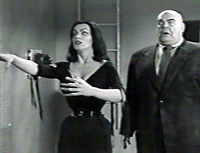|
Rotten Library > Cryptozoology > Zombies
Zombies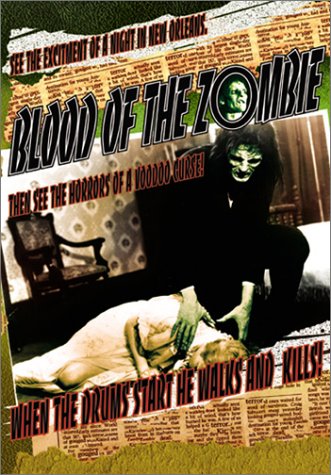 Today's youth have an unparalleled number of undead career opportunities available.
Today's youth have an unparalleled number of undead career opportunities available. Vampirism and lycanthropy are the gold standard, offering enhanced abilities, the eternal preservation of the ego, and a certain undeniable sex appeal.
Click here to watch the video version of this article!Ghosts and poltergeists allow the soul to live on without the burden of a body that must be supported by blood or flesh. Avenging spirits (such as the Crow, Freddy or Jason) are indestructible machines with a mission and high levels of job satisfaction.But zombies... Zombies are the undead equivalent of migrant workers. Not sexy. Not indestructible. No free will. In fact, no mind at all. At best, the life of a zombie is a life of purposeful servitude. At worst, it is a life scavenging for tasty, tasty brains. The zombie experience has seen many iterations and interpretations. But let's start with the real deal -- actual zombies whose etymological pedigree is beyond reproach and who enjoy the added perk of being a real-world phenomenon. We are referring, of course, to the voodoo zombie. The most complete and exhaustive scientific study of zombies can be found in The Serpent and the Rainbow, a book by Harvard ethnobotanist Wade Davis. While his conclusions are still controversial, no one has come up with a better explanation for where zombies come from.
Hired by a team of scientists investigating suspended animation, Davis was sent to Haiti to discover the truth behind the mysterious Haitian legend of the zombi -- a mindless corpse allegedly reanimated by black magic and forced into servitude through the arts of shady voodoo experts.
The process began when a voodoo priest (known as a houngan) or some other properly educated individual decides that someone in the community has wronged him, or someone else, and must be punished. Backed by a strong cultural context and the predispositions created by the religious beliefs of the local people, houngan creates a special powdery toxin that sets the stage for zombification. The intial dosing contains large amounts of a poison known as tetrodotoxin, aka pufferfish. The pufferfish is a delicacy in Japan, where daring gourmands enjoy preparing the fish very carefully in such a way as to remove its toxic glands. If the preparation is not sufficiently careful, the diner instead goes into a deep paralytic coma that can resemble death. If the preparation is really sloppy, actual death can ensue. The line between coma and death is extremely thin, which is why the fish is suitable for zombification, naturally.
Between the trauma of being buried alive, the effects of the first drugging, the trauma of being dragged from the grave in a midnight ritual, the effects of the second drugging, and the cultural expectations of people living in Haiti, the victim's psyche was so royally fucked that they deeply, truly believed they had been transformed into a soulless, will-less undead creature and behaved accordingly -- following orders and shambling a lot. (Some victims eventually recovered their bearings, although they were never quite the same.)
Zombie Fever!The zombie tradition actually originated in the Congo, then was imported to Haiti by slaves who had been kidnapped by the French. It's not clear how long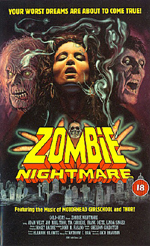 the zombie tradition existed in Africa, but the word first surfaced in English during the 19th century and was popularized among American slaves who had brought Old Country traditions to the "land of the free" when they were ripped from their homes and imported as property.
the zombie tradition existed in Africa, but the word first surfaced in English during the 19th century and was popularized among American slaves who had brought Old Country traditions to the "land of the free" when they were ripped from their homes and imported as property. By the early 20th century, the term zombie had broadened to include all sorts of mindless undead critters, including ghouls and wights, and extending eventually to any sort of robotic walking monstrosity such as Frankenstein, golems, and mentally-impaired humans with an urge to kill. In 1932, a play called "Zombie" was brought to the big screen as White Zombie starring Bela Lugosi, the beginning of an unbelievably long string of zombie-themed movies that continues unabated to this day. Something like 500 movies have been made that deal with zombies in a more than incidental fashion. The movie definition of zombie generally includes any sort of mindless undead shambler. In some cases, simply mindless will do. A taste for human flesh doesn't hurt (even though this has no root in the original zombie legend). The best known zombie flicks include:
Other entries in the genre, memorable more for their titles than for the actual films, include I Walked with a Zombie, The Incredibly Strange Creatures Who Stopped Living and Became Mixed-Up Zombies!!?, I, Zombie: A Chronicle of Pain, Psycho Zombie Love Butcher, I Was a Teenage Zombie (of course), Santo vs. the Zombies, Zombie Honeymoon, Space Zombie Bingo, Kung Fu Zombie, Zombie! vs. Mardi Gras, Zombie Cop, Confederate Zombie Massacre!, Zombie Ninja Gangbangers and Zombie Vegetarians.
|
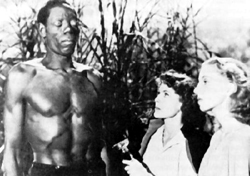 Shockingly, Davis discovered that the legends contained a large grain of truth, albeit radically misinterpreted by most audiences. According to Davis, zombis did in fact roam the Haitian countryside. However, they weren't technically undead.
Shockingly, Davis discovered that the legends contained a large grain of truth, albeit radically misinterpreted by most audiences. According to Davis, zombis did in fact roam the Haitian countryside. However, they weren't technically undead. 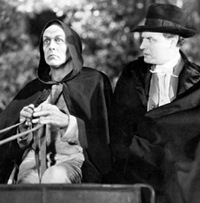 The upshot of all this, according to Davis, was that the victim appeared to drop dead after being topically exposed to the poison, which he anecdotally heard was scattered on the doorstep of a house where it entered through the victim's feet. After the victim was "dead" and buried, the houngan and his cronies would unearth him or her a few days later in a terrifying ritual enhanced by a second powder containing hallucinogenic drugs.
The upshot of all this, according to Davis, was that the victim appeared to drop dead after being topically exposed to the poison, which he anecdotally heard was scattered on the doorstep of a house where it entered through the victim's feet. After the victim was "dead" and buried, the houngan and his cronies would unearth him or her a few days later in a terrifying ritual enhanced by a second powder containing hallucinogenic drugs. 